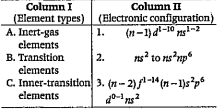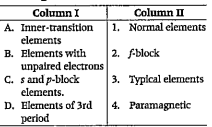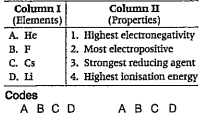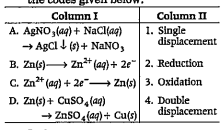Match column I with column II with respect to the nomenclature of restriction enzyme EcoRl and select the correct answer from the given codes.
ColumnIColumnIIA.E(i)1stin order of identificationB.co(ii)Name of genusC.R(iii)Name of speciesD.l(iv)Name of strain
A−(iii),B−(i),C−(ii),D−(iv)
A−(ii),B−(i),C−(iii),D−(iv)
A−(i),B−(ii),C−(iii),D−(iv)
A−(ii),B−(iii),C−(iv),D−(i)
The correct Answer is:D
Step by step video, text & image solution for Match column I with column II with respect to the nomenclature of restriction enzyme EcoRl and select the correct answer from the given codes. {:(Column I,Column II),(A.E,(i)1^(st)"in order of identification"),(B.co,(ii)"Name of genus"),(C.R,(iii)"Name of species"),(D.l,(iv)"Name of strain"):} by Biology experts to help you in doubts & scoring excellent marks in Class 12 exams.
Topper's Solved these Questions
Similar Questions
Knowledge Check
- Question 1 - Select One
Match the column I with column II and select the correct answer by the given codes
 A
A B
B C
C D
D
- Question 2 - Select One
Match the column I with column II and select correct answer by given codes
 A
A B
B C
C D
D
- Question 3 - Select One
Match the column I with column II and select correct answer by given codes
 A
A B
B C
C D
D
Match column I with column II and select the correct answer from the given codes.
Column IColumn IIA.Wax(i)Interspecific hybridisationB.Pollinator(ii)MicropopagationC.Mule(iii)BeeD.Tissue culture(iv)ApicultureView SolutionMatch column I with column II and select the correct answer from the given codes.
ColumnIColumnIIA.ampRgene(i)Artificial plasmidB.Separation of DNA fragments(ii)Selectable markerC.Hindlll(iii)ElectrophoresisD.pBR322(iv)Haemophilus influenzeaView SolutionMatch column I with column II and select the correct answer from the gives codes.
ColumnIColumnIIA.Trichoderma(i)Free living nitrogen fixing bacteriaB.Streptomyces(ii)Biocontrol agentC.Azospirillum(iii)Lactic acidD.Lactobacillus(iv)Source of antibioticView SolutionMatch the Column I with Column II and select correct answer given codes.
 View Solution
View SolutionMatch the reaction given in column I with the reaction types in column II select the correct answer from the codes given below
 View Solution
View Solution



